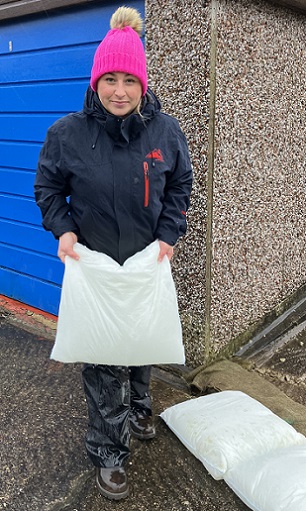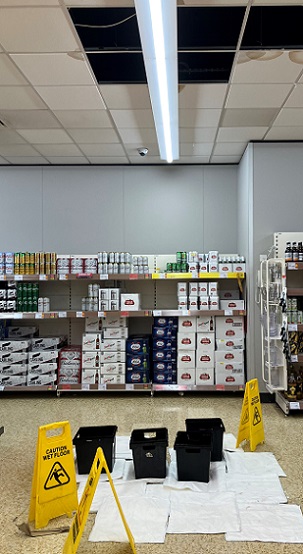 Lucy Bailey from Environmental Defence Systems Ltd with a FloodSax alternative sandbag
Lucy Bailey from Environmental Defence Systems Ltd with a FloodSax alternative sandbag
 FloodSax can also deal with internal floods such as this water seeping through a supermarket ceiling
FloodSax can also deal with internal floods such as this water seeping through a supermarket ceiling
How many named storms have hit the UK so far this autumn and winter … and why do many have such strange names?
There have already been EIGHT named storms in the UK in less than four months compared to just TWO for the whole of the storm season 2022/2023.
But what were the storms called and when did they hit the UK?
So far in the autumn and winter of 2023 and 2024 the eight storms have included three in December 2023 and have been Agnes (September 27 and 28, 2023); Babet (October 18-21, 2023); Ciaran (November 1 and 2, 2023); Debi (November 13, 2023); Elin (December 9, 2023); Fergus (December 10, 2023); Gerrit (December 27, 2023); Henk (January 2, 2024).
If you’re wondering why some of the names seem rather off-beat it’s because the UK, Ireland and the Netherlands work together as the western Europe storm naming group and people from all three countries are keen to make suggestions for names so some are rooted in culture from Ireland or the Netherlands as well as the UK.
Spain, Portugal, France, Belgium and Luxembourg make up the south-western storm naming group with Norway, Sweden and Denmark forming the northern group.
With the season running from September 1, 2023 to August 31, 2024, there is still plenty of time for far more storms to come the UK’s way.
In the year 2022/2023 the UK had just two named storms, Antoni and Betty, and both struck in summer - Antoni on August 4 and 5 with Betty on August 18 and 19 which shows that storms can happen at any point in the year.
In the UK a storm is named by the Met Office when it has the potential to cause disruption or damage which could result in an amber or red weather warning.
The Met Office says: “Storms will usually be named on the basis of the impacts from strong winds, but the impacts of other weather types will also be considered, for example rain or snow if its impact could lead to flooding as advised by the Environment Agency, Scottish Environment Protection Agency or Natural Resources Wales.”
The recent storms have caused widespread flooding throughout the UK with Nottingham and other parts of the Midlands terribly hit by the most recent storm, Henk, earlier this month.
One flood prevention company, Yorkshire-based Environmental Defence Systems Ltd, says demand for its innovative FloodSax alternative sandbags has been overwhelming.
Lucy Bailey from EDS said: “It feels like it’s hardly stopped raining since October but we saw a big surge in demand in early November for FloodSax and that has just kept on going. FloodSax are the original sandless sandbags and we have been selling them worldwide since 2007 but we’ve never known demand so high for the product, especially as it’s far more environmentally-friendly than traditional sandbags.”
FloodSax are now widely used by homeowners, businesses, councils, NHS trusts, supermarkets and facilities management companies as they are flexible and multi-use. They come in packs of five which are vacuum-packed, making them incredibly space-saving to store yet they are very easy and quick to deploy.
In their dry state they can quickly soak up water dripping or leaking inside buildings to stop damage from spreading, but immerse them fully in water and they absorb the water and retain it, transforming them into instant sandbags but without any sand. Around three million have now been sold worldwide.
It means FloodSax give instant flood protection both inside and out 24 hours a day, 365 days a year with no need to panic and try to find other kinds of flood mitigation if a storm, heavy rain or deep snow is forecast.
More on FloodSax at www.floodsax.co.uk